Preprint
Article
Fire in House – Investigation of the Outbreak and Spread of the Fire in a Countryside House
This version is not peer-reviewed.
Submitted:
18 April 2024
Posted:
19 April 2024
You are already at the latest version
A peer-reviewed article of this preprint also exists.
Abstract
Fires in houses are inevitable and they cause loss of life and major repair costs for the damage structure and contents. There is a clear need to prevent its ignition and spread to adjacent areas. This article presents the steps taken, namely: contacts, data collection, tests, analysis and conclusions regarding the accident resulting from the outbreak and spread of a fire, on December 25, 2020, in a traditional Portuguese house in Arganil, Portugal. The owners and the court requested to carry out an expert opinion by a person with specialized technical-scientific knowledge, which led to this work as an expert. the work consists of carrying out observations and data analysis. Then, the observed and analysed data were laboratory tested in order to consistently identify characteristics that lead to the ignition and propagation of the fire.
This work identified construction problems, materials used and heat sources that are responsible for the accident. The conclusions may be used to avoid future incidents or accidents with houses of same construction type.
Keywords:
Fire Study
; Construction
; Ignition Temperature
; House fire
1. Introduction
The evolution of a fire varies depending on whether it evolves in an open or confined space. Although they can follow identical paths, it is known that a fire in an open space has the obvious peculiarity of depending on the fuel and the energy dissipated, since the oxidant is practically unlimited, being a determining factor combined with meteorological conditions. The case of a confined fire presents characteristics that are the limited amount of oxygen and the fact that combustion gases are trapped in the location, with a subsequent risk of widespread combustion or explosion. According to Bishop and Drysdale (1998), initially in a confined fire, the rate of pyrolysis and energy released are affected only by the burning of fuel elements and regardless of the limits of compartmentation. A transition from a ventilation-controlled fire to a fuel-controlled fire may occur, depending predominantly on the surface area of the combustible material. A number of studies have been carried out, which are referenced by the following authors as (Raposo et al. 2017), (Vaz et al. 2019), (Barbosa, et al. 2022) and (Raposo et al. 2024).
Therefore, it is extremely important to know the combustible material and ventilation, as these factors affect the initial growth rate of the fire (Netherlands Institute for Safety Nibra, 2009). We know that fires in small, confined environments can be tragic, even in the absence of flashovers or explosions.
Most housing fires and fire incidents are the result of 5 main causes: cooking, heating, electrical distribution and lighting, intentional fire and smoking (Ahrens and Maheshwarihome, 2020), (Arruda et al. 2024) and (Campbell. 2022). Surprisingly, fires in homes are frequent in the cold months, when people spend more time inside them, at the time when people are awake, with a peak in ignitions between 5pm and 8pm, which corresponds to the time when fires occur. people return to their home, prepare meals, or are engaged in other activities inside it. Among the causes mentioned, the ones that stand out are, firstly, the activity of cooking, followed by heating and its equipment. Of the fires that start with heating, fires in fireplaces/chimneys stand out. In the case of location, we know that two thirds of accidents and deaths in fires in homes are related to fires that start in living rooms, bedrooms, and kitchens. Living room fires are an issue closely linked to chimney fires. Thus, it appears, from the data collection carried out, that the fire in the Parrozelos, Arganil house fits into the typology of fires with the aforementioned causes.
2. Methodology
The scientific methodology used resort to the inductive method which has as its starting point with observation of particular facts to, through their association, establish generalizations that allow the formulation of theory. Therefore, the work consists of carrying out observations and data analysis. With visits to the damaged house, to take the maximum information registered in photos and collecting information in personal communications, from the persons which were present during the fire. Then, the observed and analysed data were laboratory tested to consistently identify characteristics that lead to the ignition and propagation of the fire.
Laboratory tests to simulat the accident conditions, using similar materials and condition were performed, in order to demonstrate the potential for ignition of a beam in contact with the hot gases from the fireplace. K type thermocouples connected to the NI CDAQmx acquisition system via a NI9213 board, which allowed continuous recording of the temperatures reached throughout the tests, with a resolution of 1 second, were used with the program FLEXllogger from National Instruments. Additionally, the test was recorded in the infrared and visible range with the FLIR infrared (IR) camera, model SC660.
Results and Discussion
On June 21, 2021, after authorization from the court, the team moved to the incident place, the owners couple were waiting for us. After arriving at the location where the owners were. It was not possible to travel by car, we walked to the house, through narrow streets that were difficult to access. We started by interviewing the owners, who informed us that they are married, unemployed and have three children, so the loss of their home puts them in a difficult situation in socio-economic terms. They reported that the damaged house had been rebuilt between March and August 2020, by the builder from a nearby city (Leiria), without requiring a license, as its construction was prior to 1920. The owners lived in Lisbon but decided to move to the interior (Arganil) and rebuild an old family house, and to that end they used a digital platform, where they found the construction company.
The fire in the house took place on December 25, 2020, a Friday, when they had already been living in the house for more than a month. On the 24th, Christmas Eve, the family was together in the house and in addition to the household, there were other family members, including lady’s brother. On this day and taking into account the cold that can be felt at this time, the fireplace was on and continued to burn on the 25th, more than 48 hours. On the 25th, at around 4pm they felt that there was smoke, so they opened the windows. This fireplace already existed in the house before it was rebuilt, so it was only requested that the exterior structure be enlarged. The fireplace is located in the living room, on the upper floor of the house. A new roof was also placed on the house, maintaining the central wooden structure, that is, replacing the roof with a sandwich panel and inside it was fitted with a wooden false ceiling (lining). It should be noted that we consider it relevant to mention that we noticed the insertion of a beam in the fireplace chimney all the way to the inside, up to the area where hot combustion gases pass through, as can be seen in Figure 1. To feed the fireplace, the couple used Pine firewood, mostly, but also oak and olive.
After opening the windows, the smell of smoke seemed to have eased, however, at around 6pm the brother of the owner, who was on the lower floor, decided to go take a shower, and to do so he went up to the upper floor, passed through the living room living room and went to the bathroom, which was next to the fireplace room. As he passed through the room he heard a kind of crackling sound from the fire and looking at the chimney he saw sparks coming out. Thus, he noticed that the roof was on fire and at that moment they still had electricity, he immediately called owner and they started to leave the house, between 6:30 pm and 7:30 pm. A neighbor, called the firefighters (Volunteer Firefighters of Coja, Arganil), according to the records with the alarm at 7:35 pm, who arrived at the scene 45 minutes later, with 22 operators involved in fighting the flames. The family members were already abroad, couple the, the 3 children and a brother. The owner, removed the gas bottles (Figure 2) to a more distant land and the fuel from a generator.
Figure 2.
Location where the gas cylinders were removed.
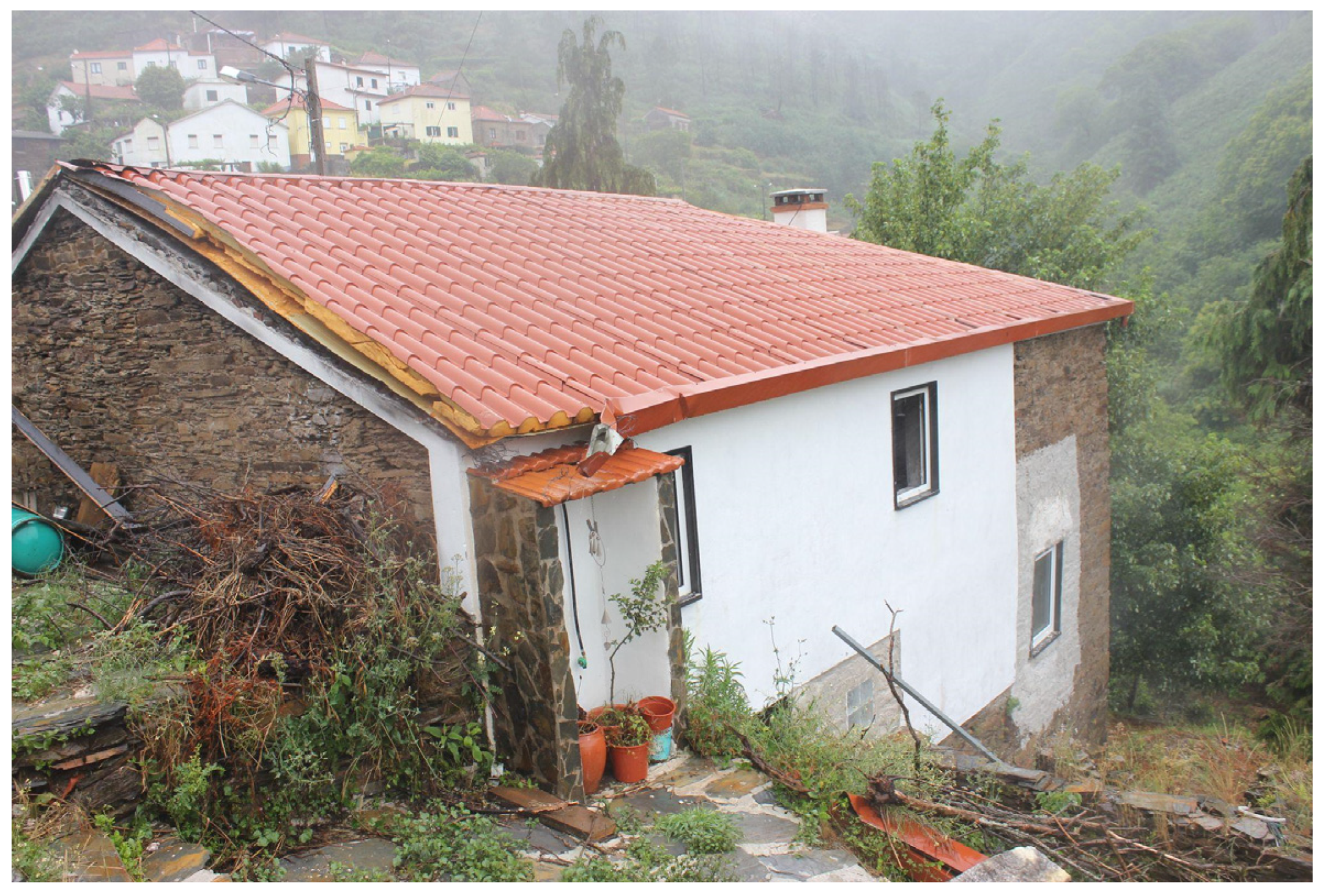
Table 1.
Data from fire.
| Alert |
17:35PM |
|---|---|
|
Ignition cause |
Fireplace, with technical flaws and connection to the ceiling lining |
| Equipment involved in the ignition | Fireplace |
| Source of heat | pine firewood |
| Extension | The entire house |
| Factors contributing to ignition | Wooden beams inside the fireplace chimney, stone-lined plasterboard wall between the chimney and the wooden lining, with sandwich panels on the ceiling. |
| Ignition place | Living room |
| Operational people | 22 elements of the firefighters |
Based on this study, with the elements collected and analysis of the data collected, we consider that the ignition occurred next to the fireplace, which was turned on and burning with woody material, with the wooden beam inside the fireplace and with the false ceiling covered with wood, as shown in Figure 3.
The cause of the ignition appears to be directly linked to the insertion of the wooden beam into the chimney structure (with dimensions of 11cm x 5cm), where it came into contact with the hot combustion gases, with temperatures exceeding 600ºC. Wood, as it is a natural polymer, when subjected to fire, undergoes depolymerization and carbonization, altering its mechanical properties, depending on the temperature reached and the time of exposure to the heat to which it was subjected. The following table shows the changes that we can observe with increasing temperature in wood.
Shafler (1973) says that woody materials undergo pyrolysis at temperatures in the order of ~300ºC. Therefore, this practice of embedding the beams, or the carelessness of not removing them, during the reconstruction, seems to be a serious failure (either of these two actions) that will certainly have led to the outcome of the fire. We also remember that an additional barrier to the release of heat was created, with the outer layer built around the chimney, which would have promoted the accumulation of heat near the lining and wooden beams, as there was rock wool insulation at the top. mineral. Commonly known as sandwich panels were placed on the roof, thin metal sheets with highly combustible polymeric material inside, which would have promoted the rapid spread of the fire across the roof (Figure 4, Figure 5 and Figure 6)
Carrying out laboratory tests simulating the accident conditions, using similar materials and conditions
In order to demonstrate the potential for ignition of a beam in contact with the hot gases from the fireplace, tests were carried out in the fire laboratory at the University of Coimbra. In the absence of widespread and standardized tests for this type of accident, the site conditions were replicated, using a vertical combustion tunnel in the laboratory, where wood chips similar to those used in a conventional fireplace were ignited and burned. calorific value of approximately 20 MJ/kg. A wooden beam measuring 11cm x 5cm was inserted through a hole in one of the sides, at a height of 2m from the base and the burning area, as at the accident site. Figure 7 shows the vertical combustion tunnel, with the wooden beam being tested.
The wooden beam was instrumented with type K thermocouples and connected to the NI CDAQmx acquisition system via a NI9213 board, which allowed continuous recording of the temperatures reached throughout the test, with a resolution of 1 second, using the FLEXllogger program from National Instruments. Additionally, the test was recorded in the infrared and visible range. Figure 7 shows a general image of the test with the FLIR infrared (IR) camera, model SC660.
Figure 8.
General image of the test with the infrared camera.
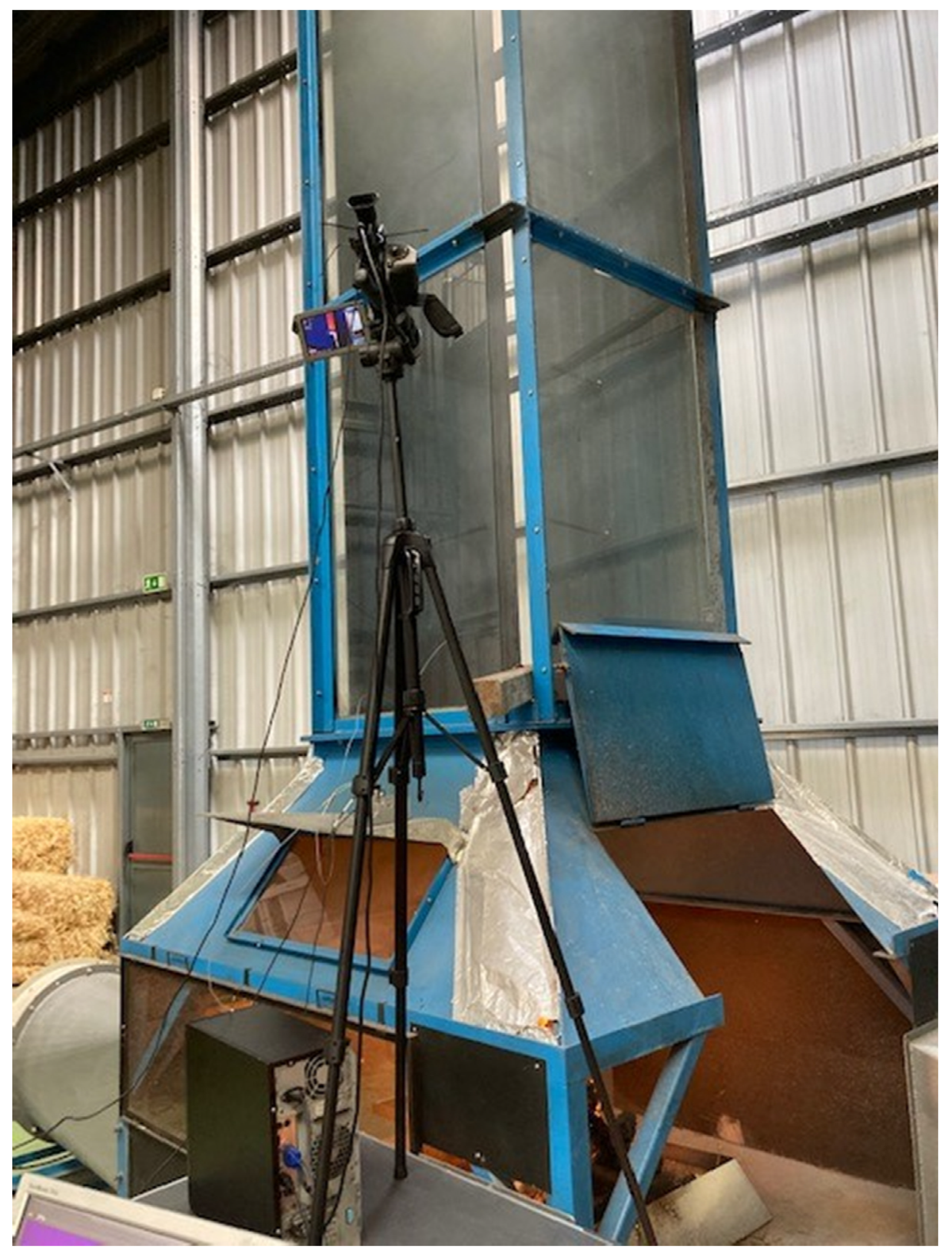
The infrared camera, model SC660, from FLIR, allowed the spatial monitoring of all recorded temperatures and the extraction of frames, which quickly allows the evolution of the test to be clarified at any time.
The recording of temperatures made it possible to identify that temperatures exceeding 360ºC were reached in the wooden beam, as can be seen in the following figures, in the yellow areas , Figure 9.
After carrying out the test, which lasted around 40 minutes, the beam was analyzed and photographed, so clearly burned areas could be seen that had combusted, despite not having had contact with the flames and only with the gases. hot, as in the case of the chimney Figure 10.
After carrying out this test and its analysis, it was verified that it was possible for the beam to start the combustion process, that is, in the chimney there were conditions to start a fire. Additionally, in the house we had the continuity of fuels, through the wooden lining on the ceiling, the electrical cables and the sandwich panels on the building's roof, as well as the chimney lining with the plasterboard support structure and stones, with connection to the wooden structure.
3. Conclusions
Taking into account the evidence found on site and after carrying out laboratory tests, it was possible to confirm that the conditions existed in the chimney house to start a fire. Additionally, in the house there was a continuity of fuels, through beams inserted in the burning area, connected to the wooden lining and with sandwich panels with just a layer of rock wool. This continuity is the result of the use of construction practices and methods that completely neglect the risk of fire. We know that woody materials, such as wood, when exposed to heat, present thermal degradation of their polymers, a reduction in their mechanical properties and the carbonization of their surface, and they ignite at temperatures of around 300ºC. Thus, this practice of embedding beams, or the carelessness of not removing them from inside a fireplace, during reconstruction, seems like a serious error that certainly led to the outcome. We also remember that an additional barrier to the release of heat was created, with the outer layer built around the chimney, which will have promoted the accumulation of heat near the lining and wooden beams and electrical cables. In the upper part there was mineral rock wool insulation that also promoted thermal insulation and heat accumulation. Commonly known as sandwich panels were placed on the roof, thin metal sheets with highly combustible polymeric material inside, which would have promoted the rapid spread of the fire across the roof.
References
- Ahrens, M.; Maheshwari, R. Home Structure Fires; National Fire Protection Association: Quincy, MA, 2020.
- Arruda, M.R.T.; Bicelli, A.R.A.; Branco, F. Ignition Locations and Simplified Design Guidelines for Enhancing the Resilience of Dwellings against Wildland Fires. Fire 2024, 7, 40. [CrossRef]
- Bishop, S. R., & Drysdale, D. D. Fires in Compartments: The Phenomenon of Flashover. Philosophical Transactions: Mathematical, Physical and Engineering Sciences, 1998). 356(1748), 2855–2872. http://www.jstor.org/stable/55052. [CrossRef]
- Barbosa, T.F.; Reis, L.; Raposo, J.; Viegas, D.X. A Protection for LPG Domestic Cylinders at Wildland-Urban Interface Fire. Fire 2022, 5, 63. [CrossRef]
- Drysdale, Dougal. An introduction to fire dynamic - 2nd ed.UK 1998.
- Vaz, G.; Raposo, J.; Reis, L.; Monteiro, P.; Viegas, D. Rigid Protection System of Infrastructures against Forest Fires. Fire 2022, 5, 145. [CrossRef]
- Viegas, D.X.; Almeida, M.; Ribeiro, L.; Raposo, J.; Viegas, M.T.; Oliveira, R.; Alves, D.; Pinto, C.; Humberto, J.; Rodrigues, A.; et al. O Complexo de Incêndios de Pedrógão Grande e Concelhos Limítrofes, Iniciado a 17 de Junho de 2017; CEIF/ADAI/LAETA: Coimbra, Portugal, 2017.
- Raposo J., Raposo., H., Farinha, J., Pais, J. Fires in Urban Passenger Transport Vehicles. Public Transport 2024.
- Richard Campbell. Caused by Electrical Failure or Malfunction. Quincy, MA: National Fire Protection Association, 2022.1, p. 1.
- Schaffer, E. L. 1973 Effect of Pyrolytic Temperatures on the Longitudinal Strenght of Dry Douglas Fir. Journal of Testing and Evaluation,v. 1, n. 4, p319-329.
- Netherlands Institute for Safety Nibra. Consumer Fire Safety: European Statistics and Potential Fire Safety Measures; Netherlands Institute for Safety Nibra: Arnhem, The Netherlands, 2009.
Figure 1.
Image of the chimney of the fireplace structure and the ceiling of the house.
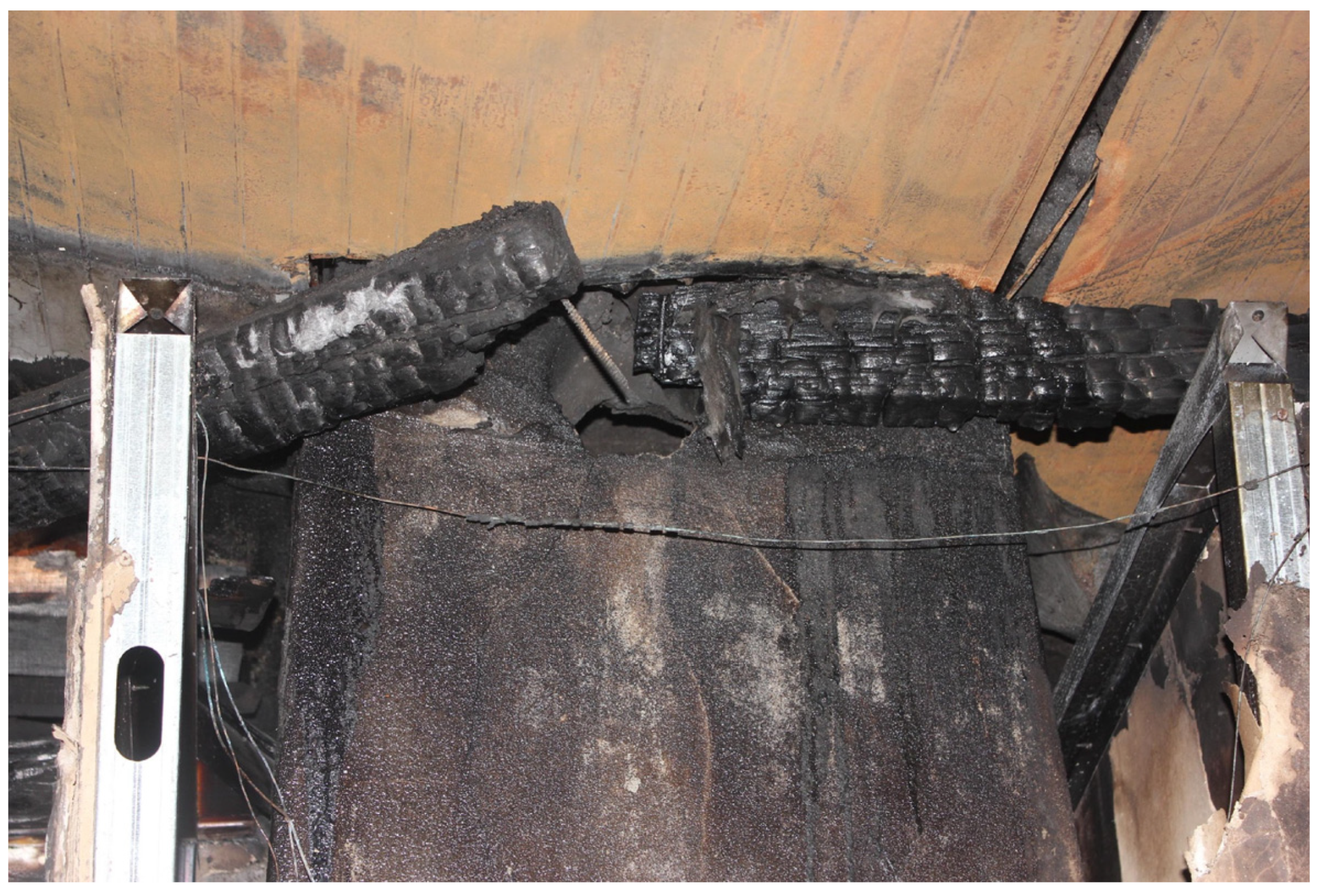
Figure 3.
plasterboard wall, covered with stone, and a wooden ceiling encompassing a beam inside the fireplace, without ventilation.
Figure 3.
plasterboard wall, covered with stone, and a wooden ceiling encompassing a beam inside the fireplace, without ventilation.
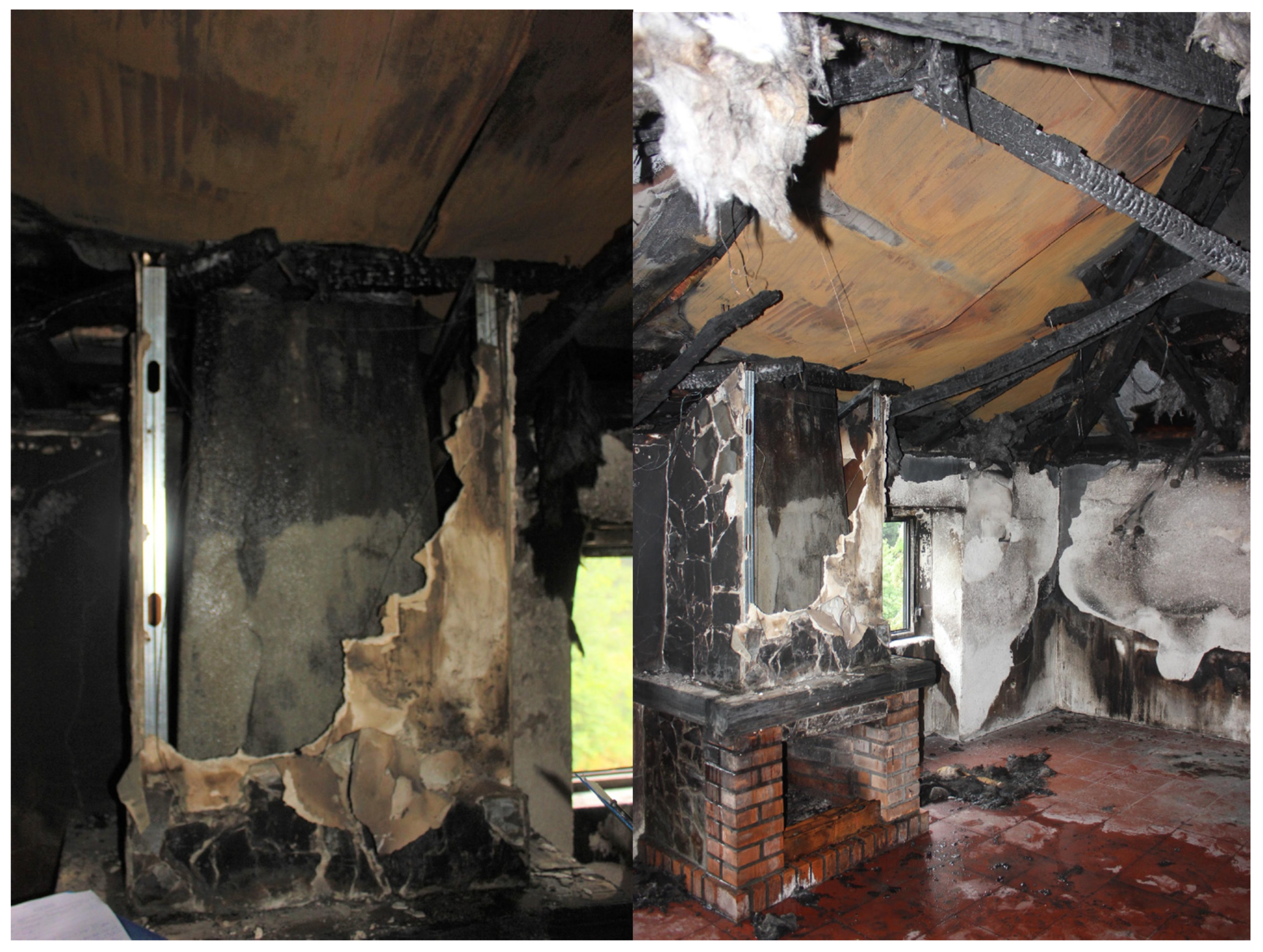
Figure 4.
Place next to the fireplace where the lining, mineral wool and sandwich panel filling were completely consumed, in the living room.
Figure 4.
Place next to the fireplace where the lining, mineral wool and sandwich panel filling were completely consumed, in the living room.
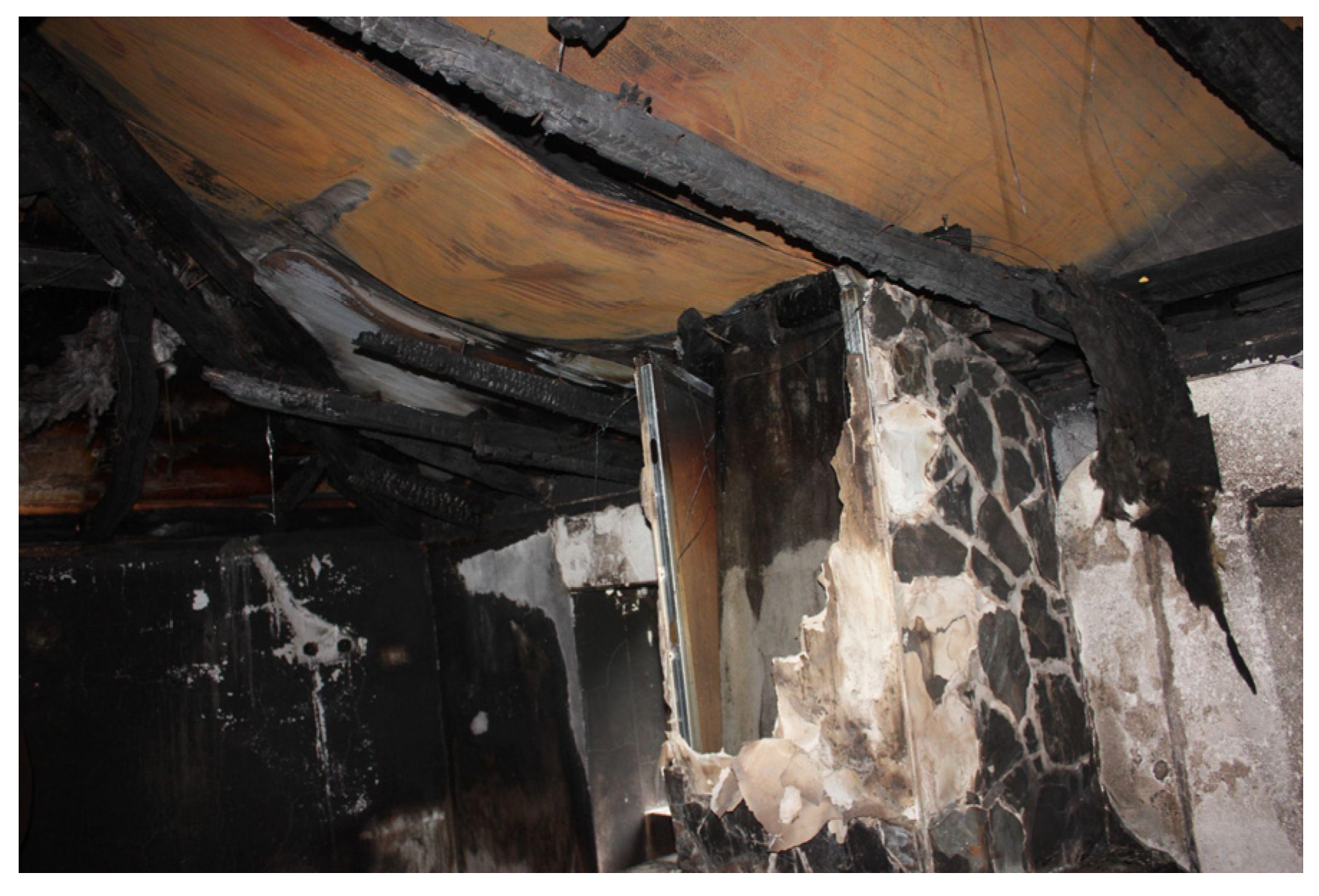
Figure 5.
Location of the house where the ceiling was not consumed by fire.
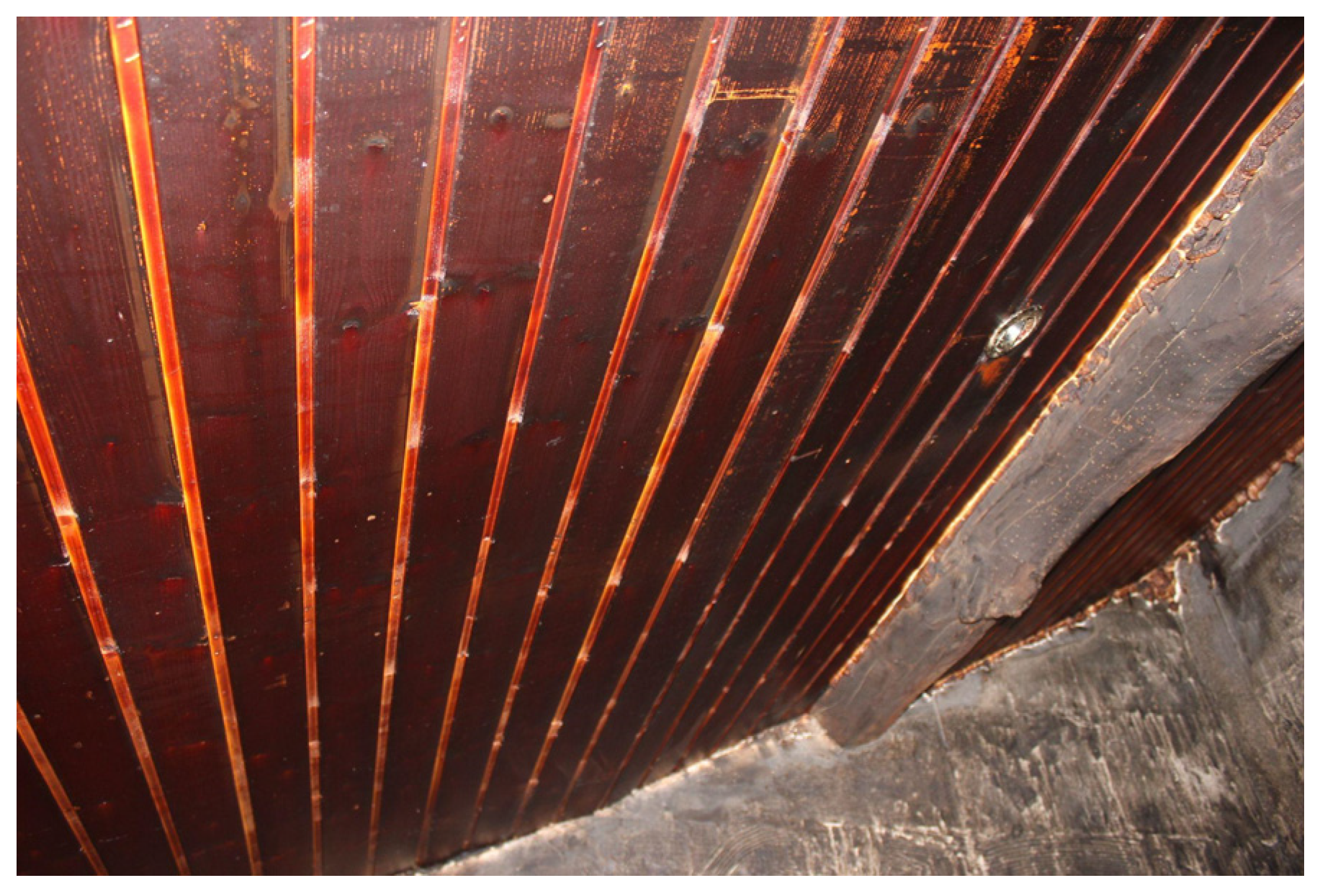
Figure 6.
Spread through the living room ceiling, completely destroyed.
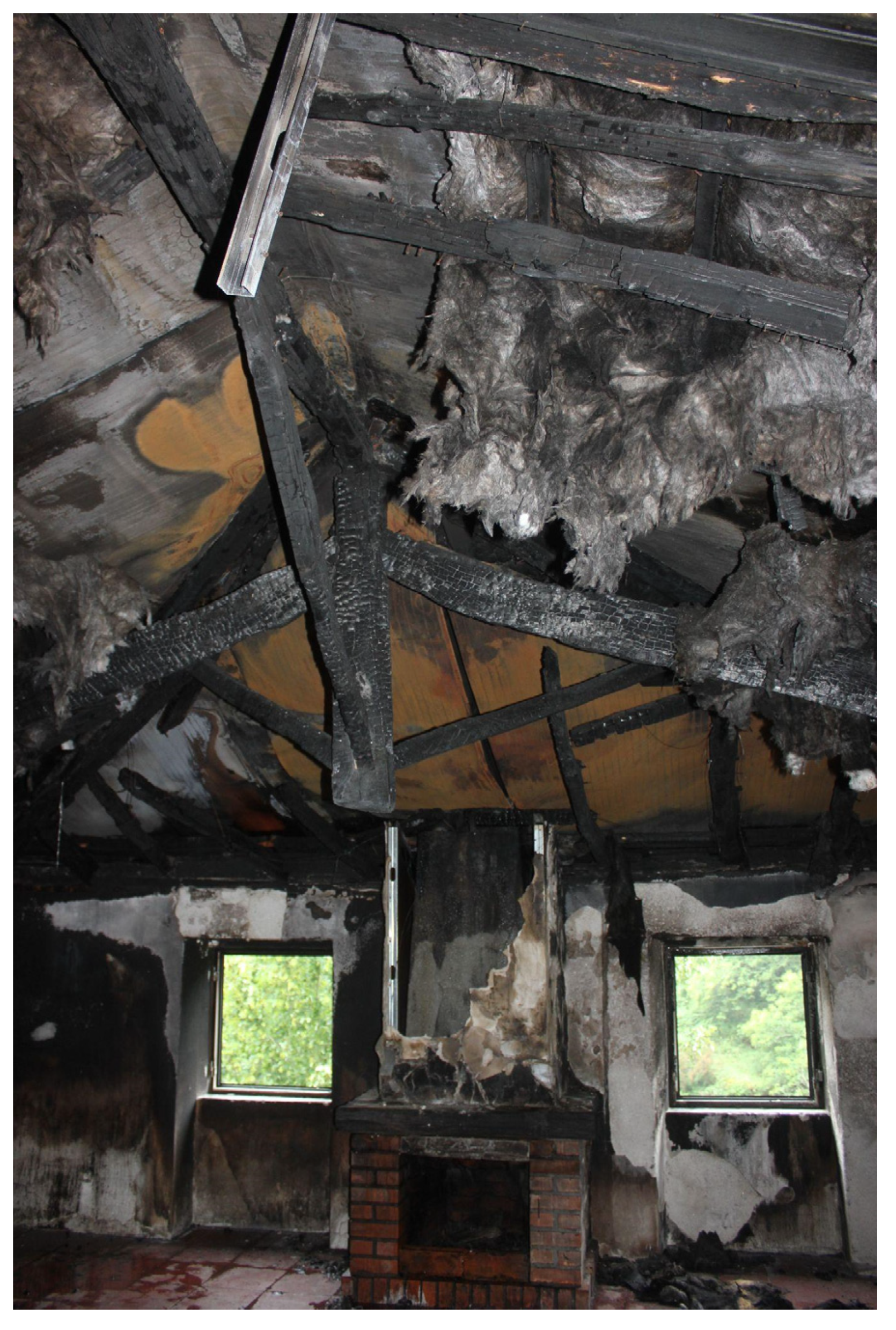
Figure 7.
Vertical combustion tunnel, with wooden beam during the test.
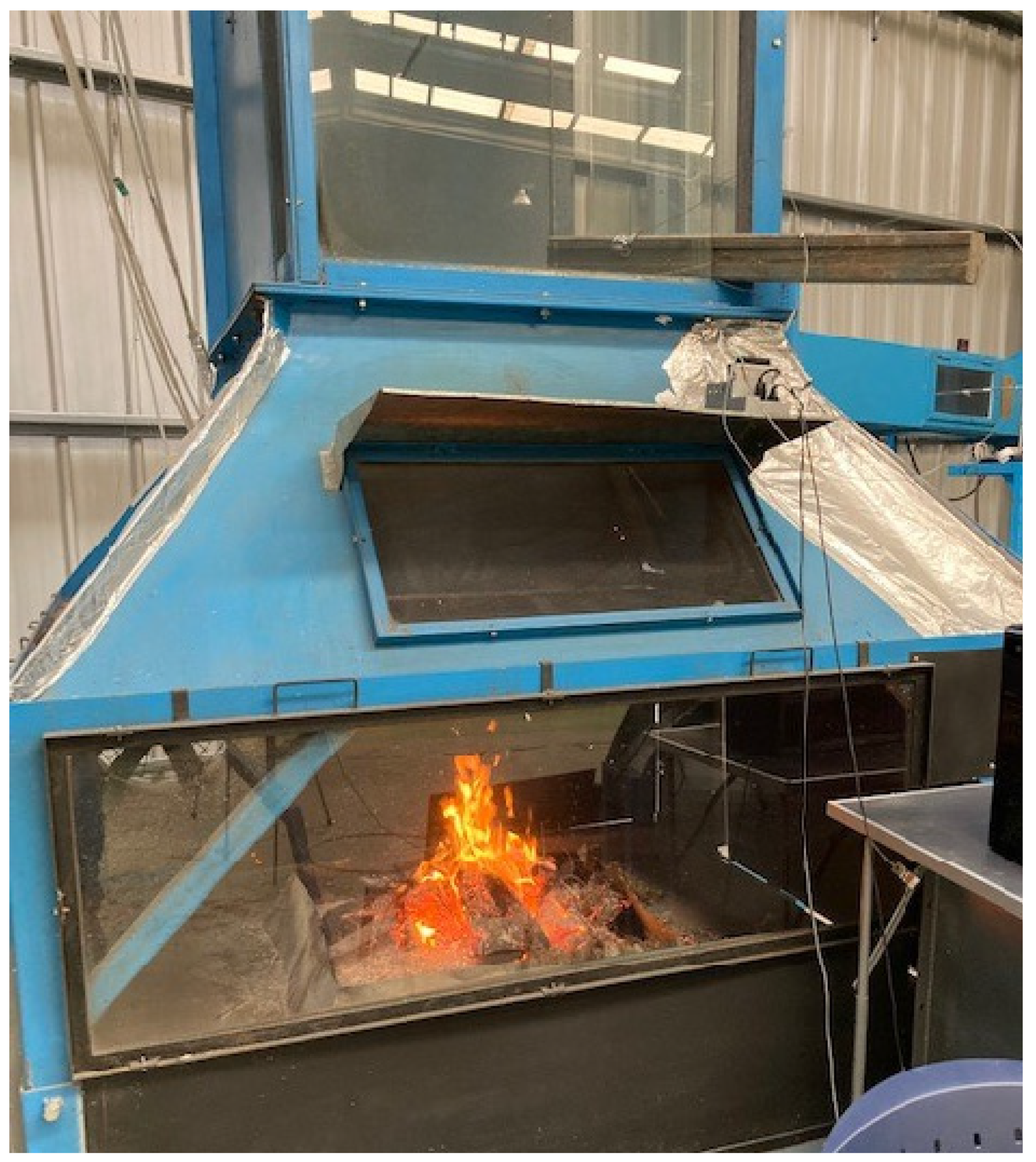
Figure 9.
Thermal images from the infrared camera with the beam under test (general view and detail of the beam).
Figure 9.
Thermal images from the infrared camera with the beam under test (general view and detail of the beam).
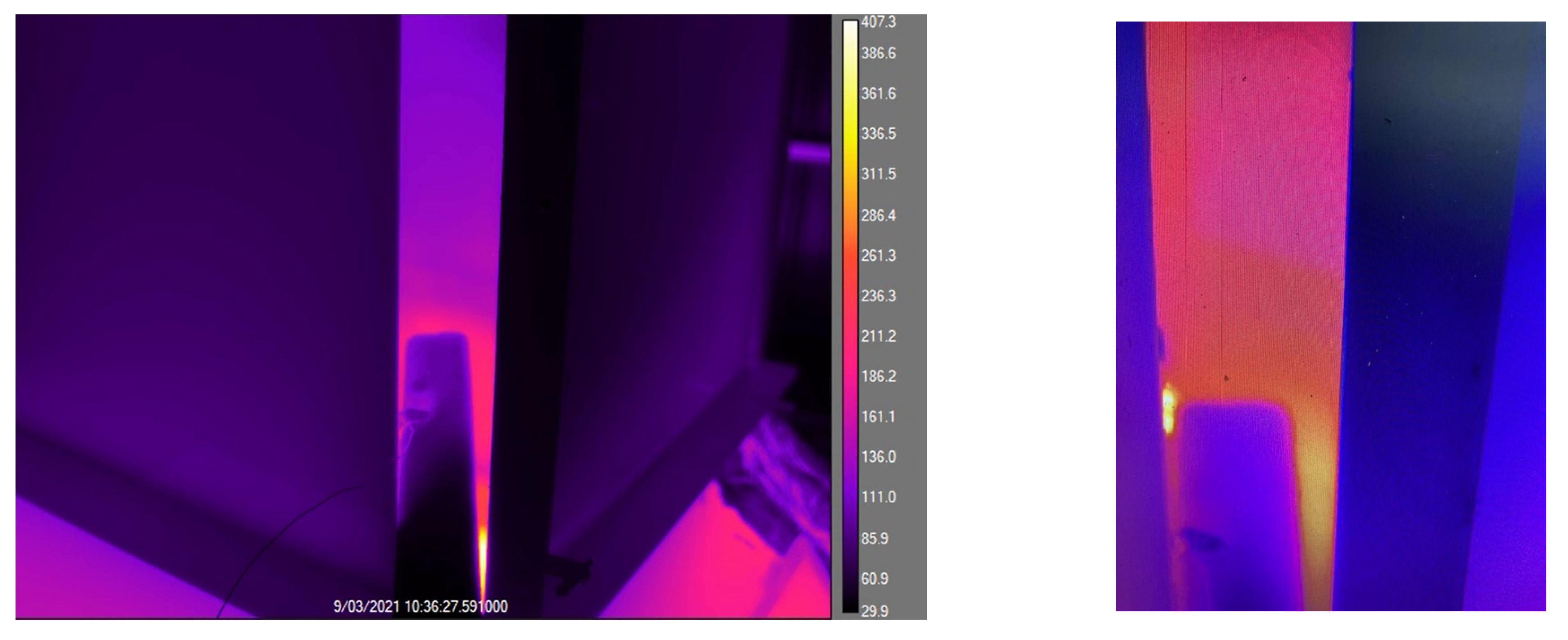
Figure 10.
Image with wooden beam with evident pyrolysis and carbonization zone.
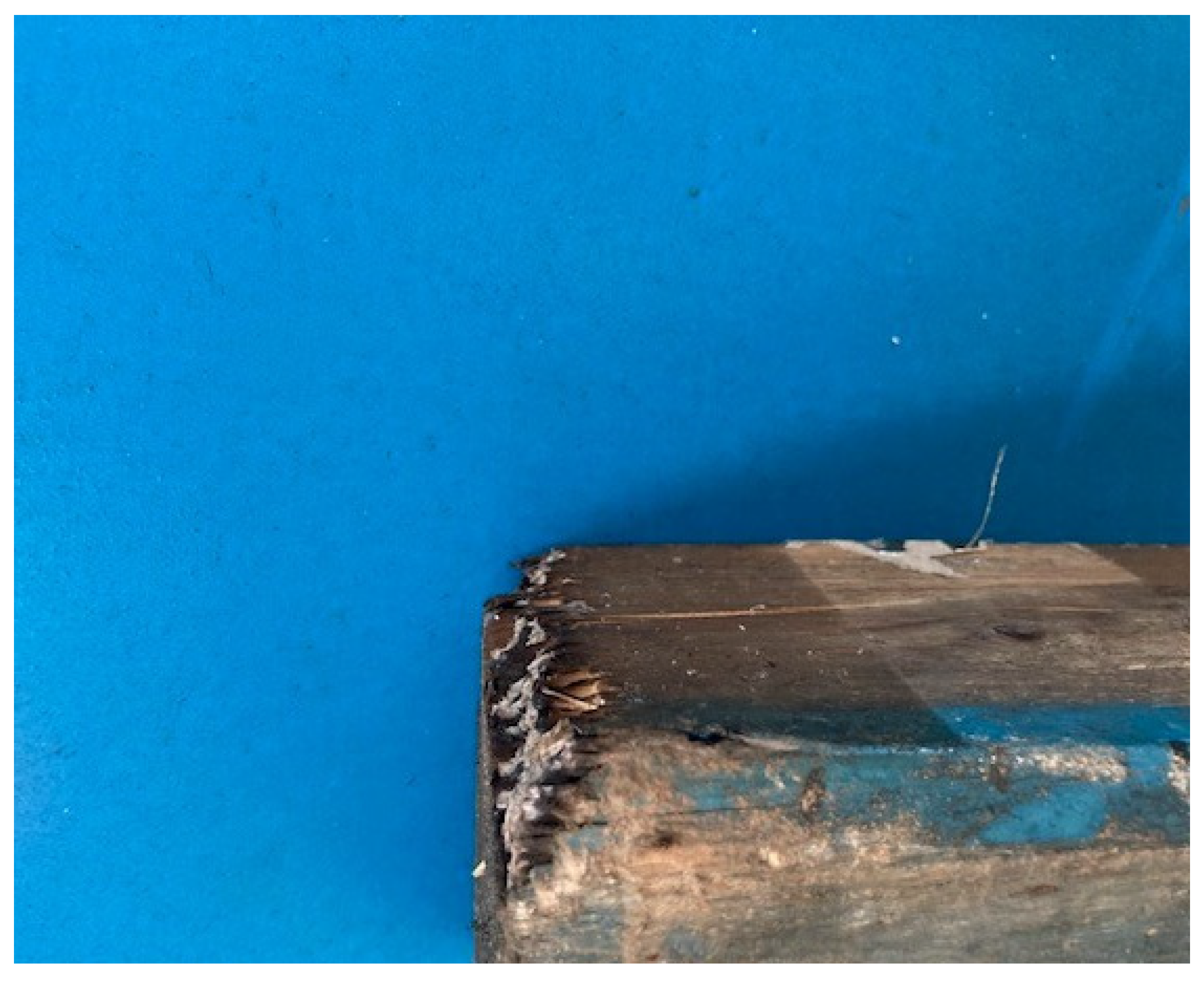
Disclaimer/Publisher’s Note: The statements, opinions and data contained in all publications are solely those of the individual author(s) and contributor(s) and not of MDPI and/or the editor(s). MDPI and/or the editor(s) disclaim responsibility for any injury to people or property resulting from any ideas, methods, instructions or products referred to in the content. |
© 2024 by the authors. Licensee MDPI, Basel, Switzerland. This article is an open access article distributed under the terms and conditions of the Creative Commons Attribution (CC BY) license (http://creativecommons.org/licenses/by/4.0/).
Copyright: This open access article is published under a Creative Commons CC BY 4.0 license, which permit the free download, distribution, and reuse, provided that the author and preprint are cited in any reuse.
Downloads
73
Views
65
Comments
0
Subscription
Notify me about updates to this article or when a peer-reviewed version is published.
MDPI Initiatives
Important Links
© 2025 MDPI (Basel, Switzerland) unless otherwise stated








